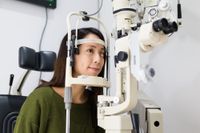
When your eyes focus on a central point, how much of the surrounding area you can see is your field of vision. This phenomenon means you see not only what is straight ahead, but nearby objects such as wall art above the point or furniture below it. If you want to schedule an eye exam, but are unfamiliar with visual field testing, take a moment to learn why you should and what tests are available.
What Should You Know About Visual Field Tests?
What Is a Visual Field Test
A visual field test examines the scope of vision in both eyes, which includes peripheral, or side, as well as central vision. The test tells your eye doctor where your side vision starts and finishes, and whether any blind spots or scotomas are present. This unique eye exam determines where each blind spot is as well as the size and shape to diagnose eye diseases such as glaucoma or determine the disease severity.
Why They Matter
Visual field testing provides early  glaucoma identification to assess damage to the optic nerve. While it is essential to glaucoma prevention and treatment, visual field testing also identifies retinal diseases such as retinitis pigmentosa that can cause blindness. Tests also check for ptosis, or drooping eyelids, retinal toxicity from certain medications, and to diagnose brain tumors, high blood pressure, macular degeneration, and stroke. The sooner a doctor identifies an eye disease or a related condition, the easier it is to slow symptom progression and adequately treat the problem before it becomes too severe to cure.
glaucoma identification to assess damage to the optic nerve. While it is essential to glaucoma prevention and treatment, visual field testing also identifies retinal diseases such as retinitis pigmentosa that can cause blindness. Tests also check for ptosis, or drooping eyelids, retinal toxicity from certain medications, and to diagnose brain tumors, high blood pressure, macular degeneration, and stroke. The sooner a doctor identifies an eye disease or a related condition, the easier it is to slow symptom progression and adequately treat the problem before it becomes too severe to cure.
Types Of Tests
The most common type of visual field eye exam is the confrontation test where you look at an object in front of you with one eye closed. Most eye doctors hold up their fingers during these tests and ask patients to count how many they see out of their side vision. Amsler grid testing checks central vision and requires the patient to look at a center dot on a grid and report how many of the lines are faded, warped, or have parts missing.
Automated perimetry testing asks patients to signal when they see flashes of light while gazing at a white bowl, while frequency doubling perimetry testing uses flickering images to detect glaucoma-related field loss. Kinetic perimetry testing checks the entire field of vision and requires patients to indicate when they can see light in their side vision. Patients typically press buttons during any visual field eye exam to register where they see the lines or light flashes.
Visual field tests are among the eye exam services from Eye Care Locale in Dayton, OH. Optometrist Dr. Barry Gridley has provided area residents with comprehensive eye care services since 1974 in addition to offering a fantastic selection of eyeglasses and contact lenses. Call (937) 222-2452 today to schedule an eye exam or fill out a patient form online. Like their Facebook page for more eye care tips.
About the Business
Have a question? Ask the experts!
Send your question

